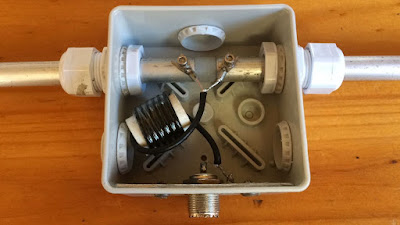Danie ZS1DBJ George: Ek het weer bietjie gespeel met my magnetiese lus antenna en ingestel op 18.1Mhz. Coax gebruik vir die kapasitor. Elke cm is ongeveer 1pF.
Hentie ZS1LH Mosselbaai vra: Danie sal die lus kan resoneer op 3,67 en/of 7,100?
Ek dink aan iets vir Danabaai as ek daar tussen die klomp ou mense gaan woon.
Nick ZS1N Boggomsbaai vra: Danie wat is die omtrek van die lus?
Danie ZS1DBJ: Nick hier is mates. Verkoeling tipe koperpyp.
Abe ZS1ZS Mosselbaai: Danie is ons boffen met Magnetiese Lus Antennas. 80m mag dalk 'n opsie wees Hentie, darem nie te groot nie.
Abe ZS1ZS Mosselbaai: Wag so 'n jaar gelede by Henry ZS1AAZ en hy het 'n monster gemaak wat 'n vacuum tube gerbruik. Hy het ook 'n MFJ wat hy in sy agterplaas opgesit het. Ook 'n probleem met kompleks wat nie van antennas hou nie.
Danie ZS1ZS George: Nie boffin nie. Maar wel proeffin. Net proefnemings. Vir 80 meter moet die lus baie groter wees.


Magnetiese lus antenna deur Danie ZS1DBJ. Die koperlus het ń diameter van so 650mm en is gemaak van 16mm diameter koperpyp. Die koperpyp is afkomstig van ń verkoelings besigheid. Dit is sagte koper en maklik buigbaar. Die plastiese houers is afkomstig van gordyn reelings. Die kapasitor vir die lus bestaan uit RG213 coax. Die kapasitansie vir die coax kapasitor was bepaal deur ń verstelbare kapasitor op die lus te koppel en met analiseerder die waarde te bepaal vir resonansie teen 18.104Mhx. ń Lengte RG213 coax is toe aan my kapasitansie meter gekoppel en stukkie vir stukkie korter gemaak totdat coax kapasitor en toets kapasitor se kapasitansie lesings eners was. Die gesnyde coax is toe aan lus gekoppel en met behulp van antenna analiseerder verder "getrim" vir resonansie op 18.104Mhz. Die volgende stap is om 2 klein stukkies PC bord aan onderkant van coax aan te bring vir "fine tune" aangesien die antenna ń baie hoë Q waarde het en is baie gevoelig op verskillende posisies. Ek sal moet kyk na motor beheer vir die "fine tune" kapasitor. Lus se koppeling met radio is via die "gamma matching rod". Die verstelling vir 50 Ohm word gedoen deur ń kortsluit brug op die lus en "matching rod" te skuif. ń SWR waarde van 1.3 en Ohmwaarde van 50 kon bereik word. Die Icom 7300 se SWR toets fasiliteit het ook ń goeie SWR aangedui. Toetse is tot 20 Watt uitset beperk aangesien ek nie seker is van RG213 se isolasie spanning tussen geleier en afskerming nie. Op ontvangs is die antenna redelik vry van geraas.



















